

Inergy Technologies - Power For Life. Custom size and flexible shapes modules. Outback IBR-2-48-175 Battery Rack. Outback Integrated Battery Rack System IBR-2-48-175 Shipping Note: This item must ship by truck freight.
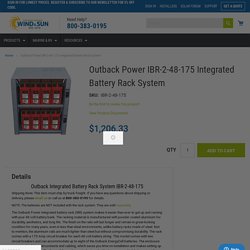
If you have any questions about shipping or delivery, please email us or call us at 800-383-0195 for details. NOTE: The batteries are NOT included with the rack system. How to Connect a Portable Generator to a House: 14 Steps. WikiHow is a “wiki,” similar to Wikipedia, which means that many of our articles are co-written by multiple authors.
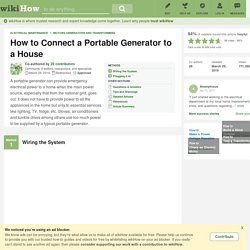
To create this article, 28 people, some anonymous, worked to edit and improve it over time. wikiHow marks an article as reader-approved once it receives enough positive feedback. This article received 13 testimonials and 94% of readers who voted found it helpful, earning it our reader-approved status. This article has been viewed 771,595 times. Learn more... How to Choose a Solar Charge Controller. Do you need a charge controller for your off-grid solar power system but you don't know which one to choose?
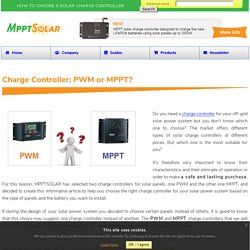
The market offers different types of solar charge controllers at different prices. But which one is the most suitable for you? It's therefore very important to know their characteristics and their principle of operation in order to make a safe and lasting purchase. 6 Best Solar Charge Controllers. Every solar-powered system requires regulation to prevent battery damage, which is why we’ve collected a list of the very best solar charge controllers for a variety of uses.
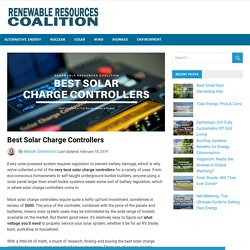
From eco-conscious homeowners to self-taught underground bunker builders, anyone using a solar panel larger than small trickle systems needs some sort of battery regulation, which is where solar charge controllers come in. Most solar charge controllers require quite a hefty upfront investment, sometimes in excess of $600. The price of the controller, combined with the price of the panels and batteries, means solar system users may be intimidated by the wide range of models available on the market. Solar Charge Controllers: MPPT And PWM Basics. Reading Time: 3 minutes. Charge Controller Types.
Introduction This section will go over charge controller types and their purpose.

We will look at the benefits of each controller and why one is better in a certain situation that another. We will also look at sizing different kinds of controllers. What batteries are used in solar + storage projects? Incorporating energy storage into a solar array is not as easy as just picking a battery off the shelf.
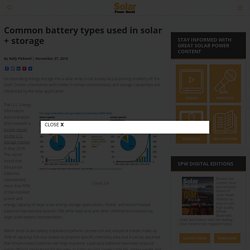
Certain chemistries work better in certain environments, and storage capabilities are influenced by the solar application. Credit: EIA The U.S. Energy Information Administration (EIA) released a trends report on the U.S. storage market in May 2018. The report found that lithium-ion batteries represented more than 80% of the installed power and energy capacity of large-scale energy storage applications. Deep Cycle Batteries & Solar Batteries. Solar Battery Interconnect Cables.
AltE Battery Interconnect Tip: All of our Battery interconnect cables are fitted with 3/8" (10mm) terminal lugs.
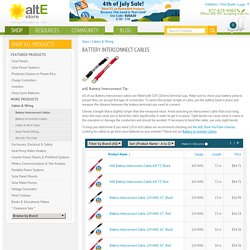
Make sure to check your battery posts to ensure they can accept this type of connection. To select the proper length of cable, put the battery bank in place and measure the distance between the battery terminals you need to connect. Choose a length that is slightly longer than the measured value. Avoid selecting an interconnect cable that is too long, since this may cause you to bend the cable significantly in order to get in in place. Battery Basics - Guide to Batteries. If you have done any research on how batteries work or what you should look for when selecting the best high performance battery, you're probably buried in information, some of which is conflicting.
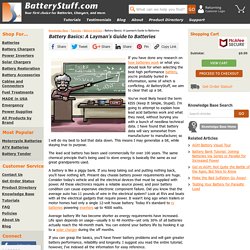
At BatteryStuff, we aim to clear that up a bit. You've most likely heard the term KISS (Keep It Simple, Stupid). I'm going to attempt to explain how lead acid batteries work and what they need, without burying you with a bunch of needless technical data. I have found that battery data will vary somewhat from manufacturer to manufacturer, so I will do my best to boil that data down. 5 Battery Types Explained - Sealed, AGM, Gel. 1.
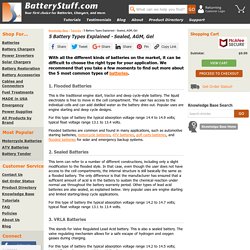
Flooded Batteries This is the traditional engine start, tractor and deep cycle-style battery. The liquid electrolyte is free to move in the cell compartment. The user has access to the individual cells and can add distilled water as the battery dries out. Popular uses are engine starting and deep cycle designs. For this type of battery the typical absorption voltage range 14.4 to 14.9 volts; typical float voltage range 13.1 to 13.4 volts. Flooded batteries are common and found in many applications, such as automotive starting batteries, motorcycle batteries, ATV batteries, golf carts batteries, and flooded batteries for solar and emergency backup systems. Pure Sine Wave vs. Modified Sine Wave Inverters. Inverter The primary job of an inverter is to convert the DC (Direct Current) power from the battery bank or solar panels to AC (Alternating Current) power needed for most appliances.

To do that, it must take the constant DC voltage and change it to a sine wave curve that goes above and below 0 volts. When inverters first came out, the most common way to do this was to make the voltage go straight up and down, creating a blocky signal. This is called modified sine wave, seen in orange in the image below. Deep Cycle Batteries Guide : Energy Storage - Energy Matters. How much electricity does a solar panel produce?
The amount of electricity a solar panel produces depends on three important factors: the size of the panel, the efficiency of the solar cells inside, and the amount of sunlight the panel gets. We’ll break down what you can expect from a typical solar panel, and how that power output compares to the power you need for the gadgets and appliances you use inside your home. Average Solar Panel Size When we say “solar panel,” what we’re talking about is a typical 60-cell silicon photovoltaic panel for residential use. These days, most home solar panels are about 65 inches high by 39 inches wide, or 5 and a half feet tall and a little more than 3 feet wide: If you look closely at the solar panel in the image above, you’ll notice 60 little squares aligned in 6 columns of 10 cells each.
Series vs Parallel Connections Explained. Introduction This section will go into more depth on series, parallel and series-parallel connections. The purpose of this section is to explain why certain connections are utilized, how to set up to your desired connection, as well as going over what is the most beneficial connection to utilize based on your situation. Why parallel? Strictly parallel connections are mostly utilized in smaller, more basic systems, and usually with PWM Controllers, although they are exceptions. Connecting your panels in parallel will increase the amps and keep the voltage the same. What Voltage Should My Battery Bank Be? 12, 24, or 48. Would you do us a huge favor by sharing? The most common question I get as a solar consultant is… What voltage should I use for my battery bank?
And Why? Almost everyone who is new to solar, wind or micro-hydro assumes that 12 volts is the way to go. It seems obvious. In the early days the choice was easy, you could only buy 12 volt inverters and 12 volt charge controllers, however 12 volts is likely not the best choice for a renewable energy system today. The most common battery voltage is now 24 volts and soon 48 volt systems will be the most popular. Homesteaders building renewable energy systems should avoid 12 volt battery banks with the following exceptions: